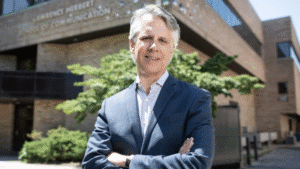By Christina Arlotta
After attending public schools most of her life, Yasel Hernandez, a high-schooler with a passion for real estate, faced a sudden academic and social change when her parents told her she was being transferred to Evergreen Charter School in Hempstead.
“For me, it was uneasy because I’ve grown up in the public schools, and I was always around the public area,” said Hernandez, now an Evergreen sophomore. “I was used to having more programs, more people around me. Now I have to wear uniforms and everything.”
Thousands of families in the Hempstead School District have chosen over the years to send their children to one of the growing number of taxpayer-funded charter schools within the area. Some parents believe the academics are better; others say school security is tighter. For some, it’s a combination of the two.
Currently, there are two charter schools in Hempstead: Evergreen and Academy. Both were founded in 2009 and began with early elementary grades kindergarten to one. The grade levels expanded throughout the decade. By 2016, Evergreen had classes up to sixth grade and up to eighth grade by 2017. In 2020, Evergreen added all high school grades. Academy expanded faster. By 2013, Academy had kindergarten through eighth grade and added all high school classes in 2016. The Diamond Charter School, which is projected to open in Hempstead in 2026, will be the third charter in the community.
From their inception to the current day, each of the two current charter schools has consistently outperformed the public schools academically. Along with strong demand from parents and local elected leaders, that has applied pressure to Hempstead School District officials to upgrade their curricula.
In late 2015, Hempstead High officials presented a 45-page strategic plan for “school excellence” to Hempstead Superintendent Susan Johnson and then Board of Education President LaMont Johnson. The plan, crafted with input from teachers and parents, outlined a “comprehensive systems approach” aimed at recruiting, developing and training effective teachers.
When the charter schools were built and opened, a majority of Hempstead High students were not meeting state learning standards, with literacy and math exam scores and graduation rates well below New York’s averages.
The plight of Hempstead Public Schools was documented in 2018 when WCBS News aired “37%,” a reference to Hempstead High’s graduation rate then—less than half the national average. The television special shone a light on the Hempstead District’s long record of academic failure, particularly at the high school.
The program helped spur state officials to act. That year, the State Education Department added Hempstead High to the Schools Under Registration Review (SURR), a statewide list of failing schools that required the most improvement. By June 2019, Governor Cuomo signed a bill that approved monitors to help oversee the district. The full bill can be read here.
Over six years, Hempstead High’s graduation rate rose from 37% to 81% in 2020. In 2023, according to the State Education Department, the rate was 85%, virtually tied with the statewide average.


Charter schools were created to give parents more choices for their children. Alanna Klein, director of media strategy for the National Alliance for Charter Schools, said charters are designed to put the educational needs of students first.
“Charter schools exist to ensure that students’ educational needs are prioritized,” Klein said. “Our research shows a steady increase in enrollment in public charter schools as families become more informed about the public education options available to them.”
Brian Fessler, director of governmental relations for the New York State School Boards Association, said charters were established in New York to compete with underperforming district schools.
“When charter schools were first authorized back in the ’90s, one of the main goals was for these institutions to kind of operate separately from traditional public schools,” Fessler said. “They were meant to serve as a test ground or a separate opportunity to attempt or put in place differing educational systems or processes, seeing what works and what doesn’t work with the goal of the things that do work kind of trickling [into] the public education system.”

Charter schools are publicly funded institutions that operate with more autonomy than traditional public-school systems through flexible teaching practices, selective admission rules, and longer school days and years. A 2023 study by the Center for Research on Education Outcomes (CREDO) at Stanford University showed charter school attendees gained an average of 16 additional days of learning in reading and six extra days of learning in math per year.
Today, nearly four million students attend charter schools across the United States, two-thirds of whom are from low-income, Black or Latino communities. That compares with nearly 50 million students in public schools as of 2022.
Charter schools, despite their generally higher test scores and graduation rates, still face criticism from students at times. When Hernandez moved to the Evergreen Charter School, she encountered challenges in transferring her advanced middle school credits.
“I had almost 10 credits when I was in my middle school because in my middle school, they gave us a lot of programs that would help you finish high school earlier,” Hernandez explained. “Most of my credits weren’t transferred when I came to the charter school. They told me because of my grade [level] that they wouldn’t be able to give me the credits because the credits my middle school gave me were for grades that were higher like juniors or seniors. I was in the middle school taking college programs. I was taking BOCES [Board of Cooperative Educational Services], real estate and lawyer programs.”
Additionally, Hernandez said she misses the greater range of extracurricular activities that the public schools provided. “I do miss certain aspects like programs . . . ” Hernandez said. “We need more programs, and we need better education.”
Daph Jeanpirra’s parents also chose to enroll her at Evergreen Charter School. Although she was initially nervous, the friendly classmates, compassionate teachers and smaller student body made her feel welcome, she said.
“I made a lot of new friends at Evergreen. I feel like the teachers really care about our education, too. We don’t have a lot of students at Evergreen. It’s easier to have control over everybody,” said Jeanpirra, a sophomore. “There’s less fighting, less shouting, less school shootings, less kids that vape and bring drugs. I know students may find Evergreen kind of strange, but it’s not that strange for me. I kind of like it, to be honest.”







